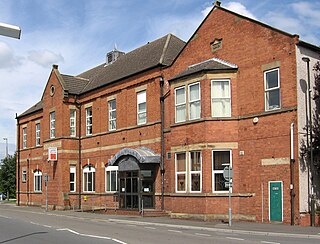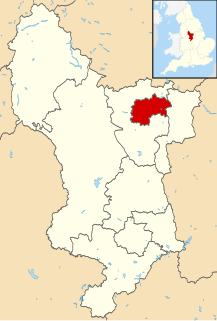
Staveley is a town and civil parish in the Borough of Chesterfield, Derbyshire, England. Located along the banks of the River Rother. It is northeast of Chesterfield, west of Clowne, northwest of Bolsover, southwest of Worksop and southeast of Sheffield.

Chesterfield is a market town and unparished area in the Borough of Chesterfield, Derbyshire, England, 24 miles (39 km) north of Derby and 11 miles (18 km) south of Sheffield at the confluence of the River Rother and River Hipper. In 2011 the built-up-area subdivision had a population of 88,483, making it Derbyshire's second largest settlement after Derby. Its borough, including Whittington, Brimington and Staveley, had a population of 103,801 in 2011. In 2011 the unparished area had a population of 76,753. It has been traced to a transitory Roman fort of the 1st century CE. The name of the later Anglo-Saxon village comes from the Old English ceaster and feld (pasture). It has a sizeable street market three days a week. The town sits on an old coalfield, but little visual evidence of mining remains. The main landmark is the crooked spire of the Church of St Mary and All Saints.

The University of Derby is a public university in the city of Derby, England. It traces its history back to the establishment of the Derby Diocesan Institution for the Training of Schoolmistresses in 1851. It gained university status in 1992.

Tapton House, in Tapton, Chesterfield, Derbyshire, England, was once the home of engineer George Stephenson, who built the first public railway line in the world to use steam locomotives. In its time Tapton has been a gentleman's residence, a ladies' boarding school and a co-educational school.

The history of Derbyshire can be traced back to human settlement since the last Ice Age, over 10,000 years ago. The county of Derbyshire in England dates back to the 11th century.

Hasland is a suburb in the south-east of Chesterfield, Derbyshire, England. Hasland is located south of Spital, east of Birdholme and north of Grassmoor. Hasland is a ward of the Borough of Chesterfield. The ward population at the 2011 Census was 6,969. The A617 links Hasland, along with Chesterfield, to the M1. Historically a village, it expanded greatly during the 20th century and now forms part of Chesterfield itself.

Temple Normanton is a village and a civil parish in Derbyshire, England. The population of the civil parish at the 2011 census was 490. It is in the North East Derbyshire district of the county.

Arkwright Town, commonly referred to as Arkwright, is a village in Sutton cum Duckmanton, North East Derbyshire, England, that is notable for having moved its location in the early 1990s. Despite its name, the village has no official town status.
Bradshaw Gass & Hope is an English firm of architects founded in 1862 by Jonas James Bradshaw (1837–1912). The style "Bradshaw Gass & Hope" was adopted after J. J. Bradshaw's death and referred to the remaining partners John Bradshaw Gass and Arthur John Hope.

The Adelphi Canal was a small privately owned canal in Duckmanton, near Chesterfield, England, built in 1799. It was used to transport pig iron from an ironworks to a wharf by a road. It is not connected to any waterway. The iron was forwarded by road to the Chesterfield Canal.

Arkwright Town railway station was in Arkwright Town, Derbyshire, England.

Technique Stadium is an all-seater football stadium in Whittington Moor, Chesterfield, Derbyshire, on the site of the former Dema Glassworks. It is the home of Chesterfield FC, replacing the Saltergate Recreation Ground as the club's stadium from the start of the 2010–11 season. Since 2019, it has also been the home stadium of Sheffield United U23s and Sheffield United Women.

Chesterfield Museum and Art Gallery is a local museum and art gallery in the town of Chesterfield, Derbyshire, England.

Buxton Crescent is a Grade-I-listed building in the town of Buxton, Derbyshire, England. Owing much to the Royal Crescent in Bath, but described by the Royal Institution of British Architects as "more richly decorated and altogether more complex". It was designed by the architect John Carr of York, and built for the 5th Duke of Devonshire between 1780 and 1789. In 2020, following a multi-year restoration and redevelopment project supported by the National Heritage Memorial Fund and Derbyshire County Council, The Crescent was reopened as a 5-star spa hotel.

Duckmanton Junction is a former railway junction near Arkwright Town in Derbyshire, England.

St Peter's Church, Edensor, is a Grade I listed church in Edensor, Derbyshire. St Peter's is the closest parish church in the Church of England to Chatsworth House, home of the Dukes of Devonshire, most of whom are buried in the churchyard. St Peter's is in a joint parish with St Anne's Church, Beeley.

Buxton Town Hall was opened in 1889 on the Market Place in Buxton, Derbyshire, England. It lies in the town's central Conservation Area overlooking The Slopes. It is a Grade-II-listed building.

The Borough of Chesterfield is a local government borough in Derbyshire, England. It is named after its main settlement of Chesterfield.

Grassmoor, Hasland and Winsick is a civil parish within the North East Derbyshire district, which is in the county of Derbyshire, England. Named for local settlements, with a mix of a number of villages and hamlets amongst a semi-rural area, it had a population of 3,360 residents in 2011. The parish is 130 miles (210 km) north west of London, 20 miles (32 km) north of the county city of Derby, and 2 miles (3.2 km) south east of the nearest market town of Chesterfield. It shares a boundary with the borough of Chesterfield, along with the parishes of Calow, North Wingfield, Temple Normanton, Tupton as well as Wingerworth. The parish paradoxically does not include the majority of the nearby built-up suburb of Hasland which is now within an adjacent unparished area of Chesterfield.



















